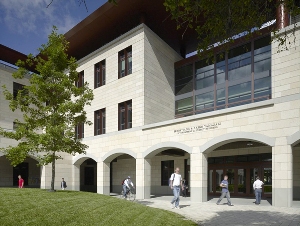Aug 12 2013
Sustainability is more than just an ideal at Stanford University's main building dedicated to environmental and energy research and teaching. It's a daily – and highly effective – work in progress for all the people who use, service and manage the "core of the environmental solar system" at Stanford, according to a prestigious new national recognition from the U.S. Green Building Council.
 The Jerry Yang and Akiko Yamazaki Environment and Energy Building received its Platinum-level environmental certification for actual building performance on a variety of sustainability measures. Credit: Tim Griffith/BOORA
The Jerry Yang and Akiko Yamazaki Environment and Energy Building received its Platinum-level environmental certification for actual building performance on a variety of sustainability measures. Credit: Tim Griffith/BOORA
The preeminent organization assessing sustainable building practices recently awarded Stanford's Jerry Yang and Akiko Yamazaki Environment and Energy Building its highest rating for existing buildings: a LEED Platinum Certification for operations and maintenance.
The LEED-EBOM rating (Existing Building: Operations and Maintenance) differs from other versions of the rating system because the certification relies on actual building performance, not design potential.
To qualify, the 166,000-square-foot building – known informally on campus as "Y2E2" – had to demonstrate efficient performance in several areas, including energy and water consumption, reduced waste going to landfills and promotion of alternative transportation for its occupants, among other standards.
During the course of the past year, evaluators assessed a variety of other factors, such as university guidelines for purchasing environmentally preferable products. In addition, Y2E2's occupants participated in building-specific commuting and thermal comfort surveys.
"This certification is more than a reflection of the incredible performance of the Y2E2 building in terms of energy, water and resource use. It is a measure of the dedication and commitment to meeting the daily challenge of sustainability of the inhabitants of the building and all the vendors and contractors that service it," said Professor Jeffrey Koseff, co-director of the Stanford Woods Institute for the Environment and chair of the Y2E2 Building Leadership Team.
"The incredible new knowledge that has been created within the Y2E2 walls over the past five years is a wonderful testament to its commitment to problem solving and sustainability in action."
When Y2E2 opened in 2008, it was the third "green" building to be completed on campus, joining the Carnegie Institution's Department of Global Ecology building and the Leslie Shao-Ming Sun Field Station at the Jasper Ridge Biological Preserve.
The four-story building, which has three levels above ground and a basement level, is filled with laboratories, offices, classrooms, collaboration spaces and meeting rooms, a popular café and inviting arrangements of couches and chairs on every floor.
It incorporates recycled building materials and high-performance fixtures promoting water conservation and recycling, and it relies as much as possible on natural lighting for illumination, as well as natural ventilation for cooling.
The $118 million project was designed to reflect Stanford's commitment to solving global environmental problems by bringing together experts from many disciplines – biologists, oceanographers, geographers, anthropologists, ecologists, economists, engineers, legal scholars and policy analysts – under one roof.
In addition to using only half the energy of an equivalent building designed with current California codes, Y2E2 achieves carbon neutrality thanks to the renewable energy sources that supply the building, both on site and off site. This distinction qualifies Y2E2 as a "Net Zero Energy" building, only the second on campus after the Knight Management Center – home of Stanford Graduate School of Business – according to the National Renewable Energy Laboratory.
"Y2E2 was the anchor high-performance building for campus that explored new territory in design, collaboration, performance and student engagement," said Fahmida Ahmed, who leads the campus Office of Sustainability. "This designation doesn't just validate Y2E2's performance in operation. The commissioning and data collection process gave us an inventory of knowledge and tools that now can benefit the rest of the high-performance buildings on campus."
The certification process spanned much of the past year and was a complex team effort, with many campus groups contributing to the project's success, in particular the Facilities Energy Management team, said Jiffy Vermylen, the sustainability program manager, who led the certification effort.
The project was coordinated through Stanford's Office of Sustainability as part of its evaluations and assessment programs with support from Science and Engineering Quad (SEQ) facilities and operations staff and the Stanford Woods Institute for the Environment. Arup, the design and engineering firm for Y2E2 and the other SEQ buildings, provided associated consulting services and engineering analysis.
"Y2E2 has shaped the thinking of its inhabitants, the university and the sustainability community. It is a truly inspiring legacy," Koseff said.